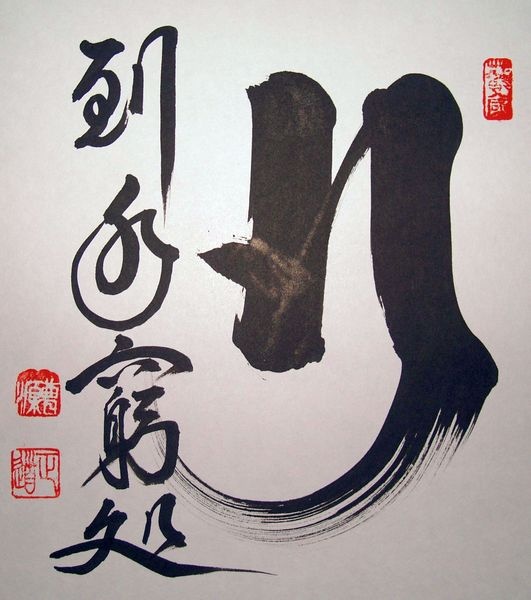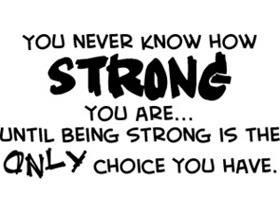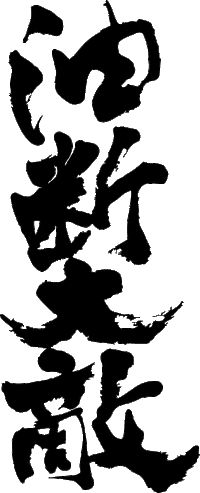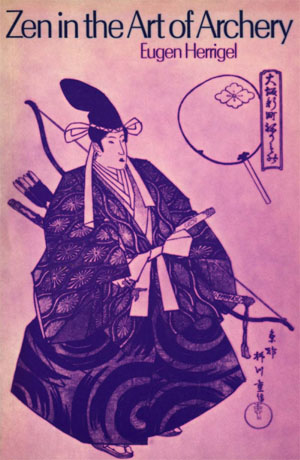 The Swordsman and the CatWritten by Issai Chozan (1659-1741)
The Swordsman and the CatWritten by Issai Chozan (1659-1741)
There was once a swordsman called Shoken, who was very much annoyed by a furious rat in his house. The rat was bold enough to come out of its hiding place even in the daytime, doing all kinds of mischief. Shoken made his pet cat go after it, but she was not its equal, and being bitten by it, she ran away screaming. The swordsman now hired some of the neighboring cats noted for their skill and courage in catching rats. They were let loose against the rat. Crouching in a corner, it watched the cats approach it and furiously attacked them one after another. The cats were terrified and all beat a retreat.
The master became desperate and tried to kill the rat himself. Taking up his wooden sword he approached it, but every effort of the experienced swordsman proved ineffectual, for the rat dodged his sword so skillfully that it seemed as to be flying through the air like a bird or even lightning. Before Shoken could follow its movement, it had already made a successful leap at his head. He was perspiring heavily and finally decided to give up the chase. As a last resort, he sent for the neighboring Cat widely known for her mysterious virtue as the most able rat-catcher. The Cat did not look in any way especially different from other cats that had been invited to fight the rat. The swordsman did not think very much of her, but let her go into the room where the rat was located. The Cat went in quietly and slowly as if she were not cognizant of any unusual scene in the room. The rat, however, was extremely terrified at the sight of the approaching object and stayed motionless, almost stupefied, in the corner. The Cat almost nonchalantly went for the rat and came out carrying it by the neck.
In the evening, all the cats who had participated in the rat-catching had a grand session at Shoken's house, and respectfully asked the great Cat to take the seat of honor. They made profound bows before her and said: “We are all noted for valor and cunning, but never realized that there was such an extraordinary rat in the world. None of us was able to do anything with it until you came; and how easily you carried the day! We all wish you to divulge your secrets for our benefit, but before that let us see how much we all know about the art of fighting rats.”
The black cat came forward and said: “I was born in a family reputed for its skill in the art. Since my kitten days I have trained myself with a view to becoming a great rat-catcher. I am able to leap over a screen as high as seven feet; I know how to squeeze myself through a tiny hole which allows a rat only. I am proficient in performing all kinds of acrobatics. I am also clever at making the rats think that I am sound asleep, but I know how to strike them as soon as they come within my reach. Even those running over the beam cannot escape me. It is really a shame that I had to retreat before that old rat today.”
The old veteran Cat said: “What you have learned is the technique of the art. Your mind is ever conscious of planning how to combat the opponent. The reason why the ancient masters devised the techniques is to acquaint us with the proper method of accomplishing the work, and the method is naturally simple and effective, implying all the essential points of the art. Those who follow the master fail to grasp his principle and are to busily occupied with improving their technical cleverness and manipulatory skill. The end is achieved, and cleverness attains its highest efficiency , but what does it all amount to? Cleverness is an activity of the mind, no doubt, but it must be in accordance with the Way. When the latter is neglected and mere cleverness is aimed at, it diverges and is apt to be abused. This is to be remembered well in the art of fighting.”
The tiger cat now stepped forward and expressed his view thus: “To my mind, what is important in the art of fighting is the spirit (ki; ch'i in Chinese); I have long trained myself in its cultivation and development. I am now in possession of the strongest spirit, which fills up heaven and earth. When I face an opponent, my overawing spirit is already on him, and victory is on my side even prior to actual combat. I have no conscious scheme as to the use of technical skill, but it comes out spontaneously according to change of situation. If the rat should be running over a beam, I would just gaze at him intensely with all my spiritual strength, and he is sure to fall by himself from the height and be my prisoner. But that old mysterious rat moved along without leaving any shadow. The reason is beyond me.”
The grand old Cat's reply was this: “You know how to make the most of your psychic powers, but the very fact of your being conscious of it works against you; your strong psyche stands opposed to the opponent's, and you can never be sure of yours being stronger than his, for there is always a possibility of its being surpassed. You may feel as if your active vigorous psyche were filling the universe, but it is not the spirit itself, it is no more than its shadowy image. It may resemble Mencius' Kozen no ki (hao-jan chi ch'i), but in reality it is not. Mencius' ch'i (“spirit”), as we know, is bright and illuminating, and for this reason full of vigor, whereas yours gains vigor owing to conditions. Because of this difference in origin, there is difference in its operation. The one is a great river incessantly flowing, and the other is a temporary flood after a heavy rainfall, soon exhausted when it encounters a mightier onrush. A desperate rat often proves stronger than an attacking cat. It has been cornered, the fight is for life and death, and the desperate victim harbors no desire to escape unhurt. Its mental attitude defies every possible danger which may come upon it. Its whole being incarnates the fighting ch'i (“spirit” or “psyche”), and no cats can withstand its steel-like resistance.”
The gray cat now advanced quietly and said: “as you tell us, a psyche however strong is always accompanied by its shadow, and the enemy is sure to take advantage of this shadow, though it may be the faintest one. I have for a long time disciplined myself in this way: not to overawe the enemy, not to force a fight, but to assume a yielding and conciliatory attitude. When the enemy proves strong, I just look yielding and simply follow up his movements. I act like a curtain surrendering itself to the pressure of a stone thrown at it. Even a strong rat finds no means to fight me. But the one we had to deal with today has no parallel, it refused to submit to my psychical overpowering, and was not tempted by my manifestation of a yielding psyche. It was a most mysterious creature – the like of which I have never seen in my life.”
The grand old Cat answered: “What you call a yielding psyche is not in harmony with Nature; it is man-made, it is contrivance word out in your conscious mind. When you try by means of this to crush the opponent's positive impassioned attaching psyche, he is quick enough to detect any sign of psychic wavering which may go on in your mind. The yielding psyche thus artificially evoked produces a certain degree of muddiness and obstruction in your mind, which is sure to interfere with acuteness of perceptions and agility of action, for then Nature feels impeded in pursuing its original and spontaneous course of movement. To make Nature display its mysterious way of achieving things is to do away with all your own thinking, contriving, and acting; let Nature have her own way, let her act as it fees in you, and there will be no shadows, no signs, no traces whereby you can be caught; you have then no foes who can successfully resist you.
“I am not, however, going to say that all the discipline you have each so far gone through has been to no purpose. After all, the Way expresses itself through its vessels. Technical contrivances hold the Reason (ri, li) in them, the spiritual power is operative in the body, and when it is harmony with Nature, it acts in perfect accord with environmental changes. When the yielding psyche is thus upheld, it gives a stop to fighting on the physical plane of force and is able to stand even against rocks. But there is one most essential consideration which when neglected is sure to upset everything. This is: not to cherish even a speck of self-conscious thought. When this is present in your mind, all your acts become self-willed, human-designed tricks, and are not in conformity with the Way. It is then that people refuse to yield to your approach and come to set up a psyche of antagonism on their part. When you are in the state of mind known as “mindlessness' (mushin), you act in unison with Nature without resorting at all to artificial contrivances. The Way, however, is above all limitations, and all this talk of mine is far from being exhaustive as far as the Way is concerned.
“Some time ago there was in my neighborhood a cat who passed all her time in sleeping, showing no sign of spiritual-animal power, and looking like a wooden image. People never saw her catch a single rat, but wherever she roamed about no rats ever dared to appear in her presence. I once visited her and asked for the reason. She gave no answer. I repeated my query four times, but she remained silent. It was not that she was unwilling to answer, but in truth she did not know how to answer. So we note that one who knows speaks not a word, while one who speaks knows not. That old cat was forgetful not only of herself but all things about her, she was the one who realized divine warriorship and killed not. I am not to be compared to her.”
Continued the Cat: “Well, I am a mere cat; rats are my food, and how can I know about human affairs? But if you permit me to say something further, you must remember that swordsmanship is an art of realizing at a critical moment the Reason of life and death, it is not meant just to defeat your opponent. A samurai ought to be always mindful of this fact and discipline himself in a spiritual culture as well as in the technique of swordsmanship. First of all, therefore, he is to have an insight into the Reason of life and death, when his mind is free from thoughts of selfishness. This being attained, he cherishes no doubts, no distracting thoughts; he is not calculating, nor does he deliberate; his Spirit is even and yielding and at peace with the surroundings; he is serene and empty-minded; and thus he is able to respond freely to changes taking place from moment to moment in his environment. On the other hand, when a thought or desire is stirred in his mind, it calls up a world of form; there is 'I,' there is 'not-I,' and contradictions ensue. As long as this opposition continues, the Way finds itself restricted and blocked; its free activities become impossible. Your Spirit is already pushed into the darkness of death, altogether losing its mysterious native brightness. How can you expect in this state of mind to rise and wager your fate against the opponent? Even when you come out victorious, it is no more than accidental, and decidedly against the spirit of swordsmanship.
“By 'purposelessness' is not meant mere absence of things where vacant nothingness prevails. The Spirit is by nature formless, and no 'objects' are to be harbored in it. When anything is harbored there, your psychic energy is drawn toward it; and when your psychic energy loses its balance, its native activity becomes cramped and no more flows with the stream.
Where the energy is tipped, there is too much of it in one direction, while in another there is a shortage. Where it is too much, it overflows and cannot be controlled; where there is a shortage, it is not sufficiently nourished and shrivels up. In both cases, it is unable to cope with ever-changing situations. But when there prevails a state of 'purposelessness' [which is also a state of 'mindlessness'] the Spirit harbors nothing in it, nor is it tipped in any one direction; it transcends both subject and object; it responds empty-mindedly to environmental vicissitudes and leaves no tracks. We have in the Book of Changes (I Ching): 'There is in it no thinking, no doing [ or no willing], absolute quietness, and no motion; but it feels, and when it acts, it flows through any objects and events of the world.' When this is understood in connection with the art of swordsmanship, one is nearer to the Way.”
After listening intently to the wisdom of the Cat, Shoken proposed this question: “What is meant by 'There is neither the subject nor the object'?”
Replied the Cat: “Because of the self there is the foe; when there is no self there is no foe. The foe means an opposition as the male is opposed to the female and fire to water. Whatever things have form exist necessarily in opposition. When there are no signs [of thought movement] stirred in your mind, no conflicts of opposition take place there; and when there are no conflicts, one trying to get the better of the other, this is known 'neither foe nor self.' When, further, the mind itself is forgotten together with signs [of thought movement], you enjoy a state of absolutely-doing-nothingness, you are in a state of perfectly quiet passivity, you are in harmony with the world, you are one with it. While the foe-form ceases to exist, you are not conscious of it. Your mind is cleansed of all thought movements, and you act only when there is prompting [from the Unconscious].
“When your mind is thus in a state of absolutely-doing-nothingness, the world is identified with yourself, which means that you make no choice between right and wrong, like and dislike, and are above all forms of abstractions. Such conditions as pleasure and pain, gain and loss, are creations of your own mind. The whole universe is indeed not to be sought after outside the Mind. An old poet sings: 'When there is a particle of dust in your eyes, the triple world becomes a narrow path; have your mind completely free from objects – and how much this life expands!' When even a tiny particle of sand gets into the eye, we cannot keep it open; the eye may be likened to the Mind which by nature is brightly illuminating and free from objects; but as soon as an object enters there its virtue is lost. It is said again that 'when one is surrounded by an enemy – hundreds of thousands in strength – this form [known as my Self] may be crushed to pieces, but the Mind is mine with which no overwhelming army can have anything to do.' Says Confucius: 'Even a plain man of the street cannot be deprived of his will.' When however this mind is confused, it turns to be its own enemy. This is all I can explain here, for the master's task cannot go beyond transmitting technique and illustrating the reason for it. It is yourself who realizes the truth of it. The truth is self-attained, it is transmitted from mind to mind, it is a special transmission outside the scriptural teaching. There is no willful deviation from traditional teaching, for even the master is powerless in this respect. Nor is this confined to the study of Zen. From the mind-training initiated by the ancient sages down to various branches of art, self-realization is the keynote of them all, and it is transmitted from mind to mind – a special transmission outside the scriptural teaching. What is performed by scriptural teaching is to point out for you what you have within yourself. There is no transference of secrets from master to disciple. Teaching is not difficult, listening is not difficult either, but what is truly difficult is to become conscious of what you have in yourself and be able to use it as your own. This self-realization is known as 'seeing into one's own being,' which is satori. Satori is an awakening from a dream. Awakening and self-realization and seeing into one's own being – these are synonymous.”
Source: Suzuki, D.T., Zen and Japanese Culture. New York: Pantheon In, 1959. Print.
















